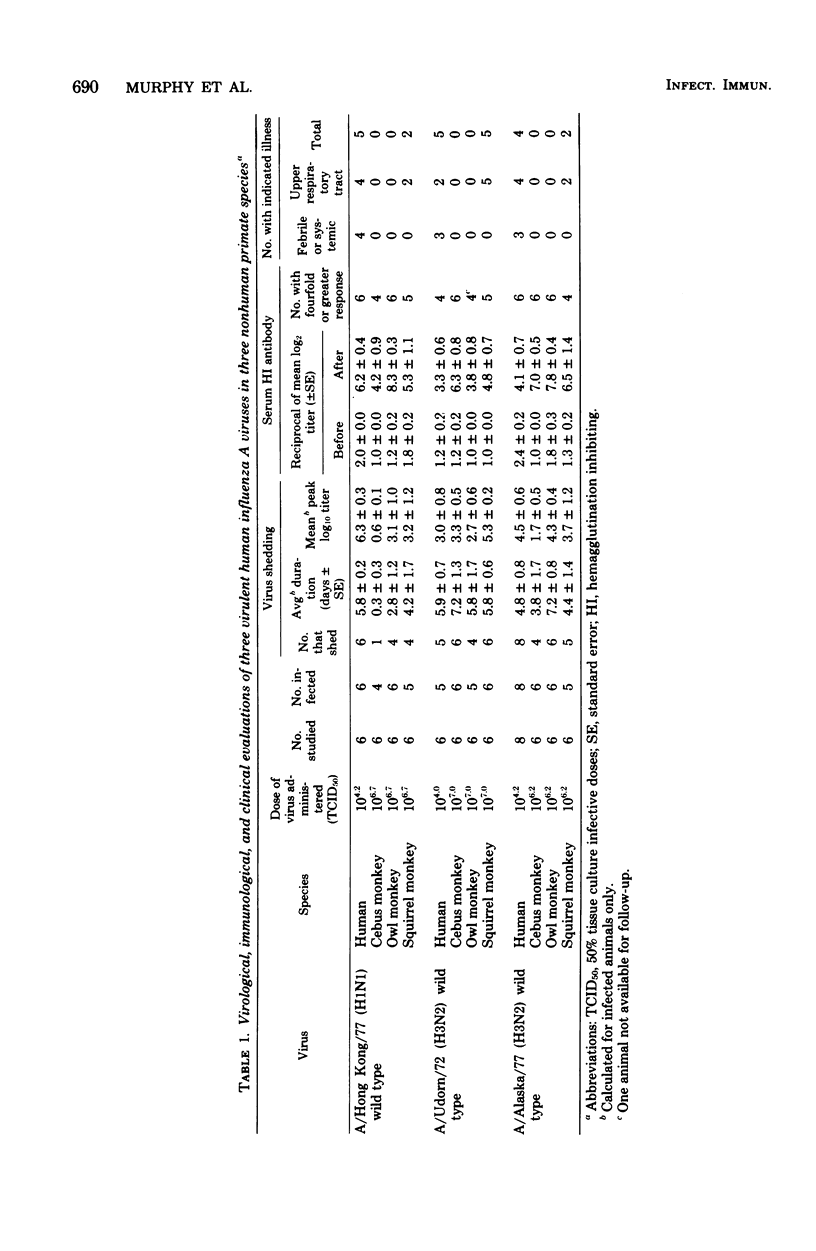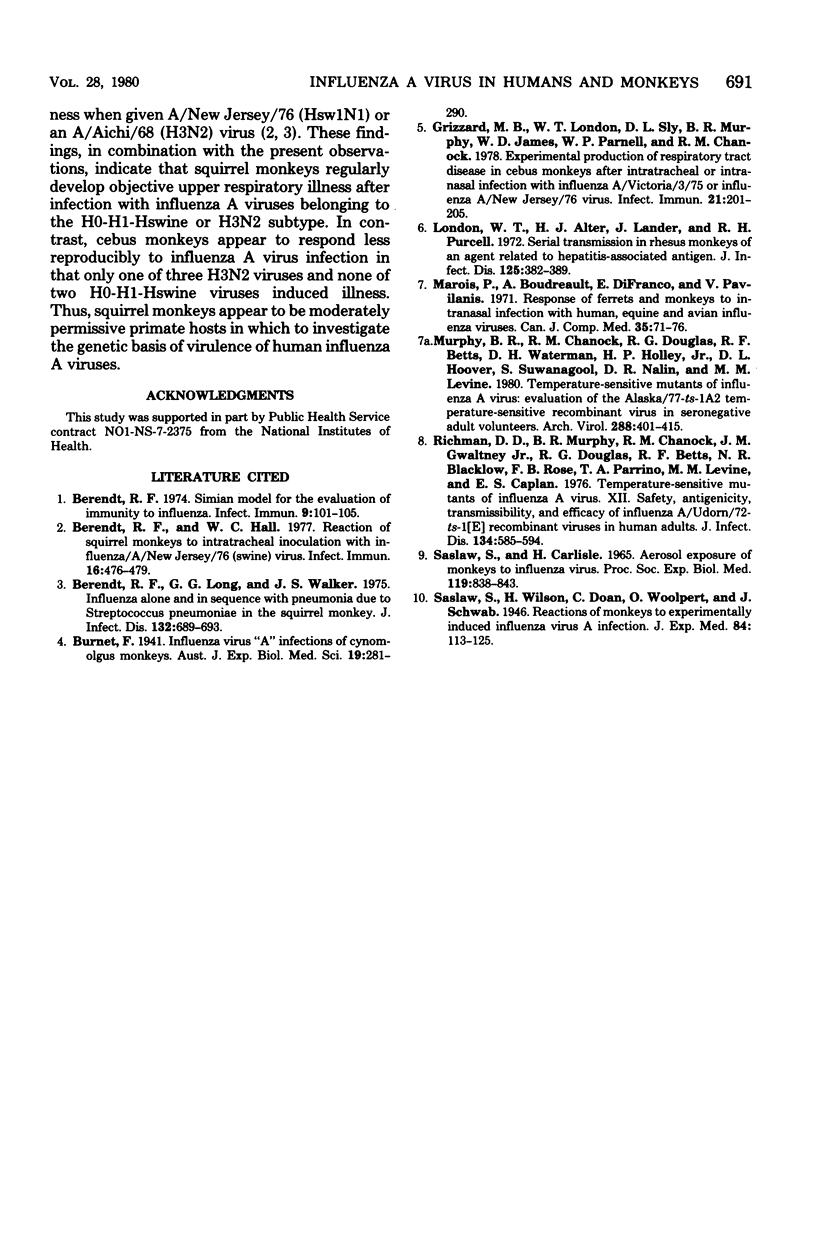Abstract
The virulence of three cloned influenza A viruses was compared in humans and in three readily available species of nonhuman primates (owl, squirrel, and cebus monkeys) in an attempt to identify a species of monkey that could be used to investigate the genetic basis of attenuation of influenza A viruses for humans. Three influenza A viruses from two subtypes, i.e., the A/Udorn/72 (H3N2), A/Alaska/77 (H3H2), and A/Hong Kong/77 (H1H1) viruses, produced febrile influenzal illness in humans. Squirrel monkeys developed mild upper respiratory tract illness in response to each of the three viruses. Illness was accompanied by a high level of virus shedding; each of nine squirrel monkeys that shed equal to or greater than 10(5.0) 50% tissue culture infective doses of virus became ill, whereas those that shed less remained well. In contrast, the cebus and owl monkeys remained clinically well despite infection with each of the three viruses. Thus, squirrel monkeys appear to be moderately permissive primate hosts in which to investigate the genetic basis of virulence of human influenza A viruses.
Full text
PDF



Selected References
These references are in PubMed. This may not be the complete list of references from this article.
- Berendt R. F., Hall W. C. Reaction of squirrel monkeys to intratracheal inoculation with influenza/A/New Jersey/76 (swine) virus. Infect Immun. 1977 May;16(2):476–479. doi: 10.1128/iai.16.2.476-479.1977. [DOI] [PMC free article] [PubMed] [Google Scholar]
- Berendt R. F., Long G. G., Walker J. S. Influenza alone and in sequence with pneumonia due to Streptococcus pneumoniae in the squirrel monkey. J Infect Dis. 1975 Dec;132(6):689–693. doi: 10.1093/infdis/132.6.689. [DOI] [PubMed] [Google Scholar]
- Berendt R. F. Simian model for the evaluation of immunity to influenza. Infect Immun. 1974 Jan;9(1):101–105. doi: 10.1128/iai.9.1.101-105.1974. [DOI] [PMC free article] [PubMed] [Google Scholar]
- Grizzard M. B., London W. T., Sly D. L., Murphy B. R., James W. D., Parnell W. P., Chanock R. M. Experimental production of respiratory tract disease in cebus monkeys after intratracheal or intranasal infection with influenza A/Victoria/3/75 or influenza A/New Jersey/76 virus. Infect Immun. 1978 Jul;21(1):201–205. doi: 10.1128/iai.21.1.201-205.1978. [DOI] [PMC free article] [PubMed] [Google Scholar]
- London W. T., Alter H. J., Lander J., Purcell R. H. Serial transmission in rhesus monkeys of an agent related to hepatitis-associated antigen. J Infect Dis. 1972 Apr;125(4):382–389. doi: 10.1093/infdis/125.4.382. [DOI] [PubMed] [Google Scholar]
- Marois P., Boudreault A., DiFranco E., Pavilanis V. Response of ferrets and monkeys to intranasal infection with human, equine and avian influenza viruses. Can J Comp Med. 1971 Jan;35(1):71–76. [PMC free article] [PubMed] [Google Scholar]
- Richman D. D., Murphy B. R., Chanock R. M., Gwaltney J. M., Jr, Douglas R. G., Betts R. F., Blacklow N. R., Rose F. B., Parrino T. A., Levine M. M. Temperature-sensitive mutants of influenza A virus. XII. Safety, antigenicity, transmissibility, and efficacy of influenza A/Udorn/72-ts-1[E] recombinant viruses in human adults. J Infect Dis. 1976 Dec;134(6):585–594. [PubMed] [Google Scholar]
- SASLAW S., CARLISLE H. N. AEROSOL EXPOSURE OF MONKEYS TO INFLUENZA VIRUS. Proc Soc Exp Biol Med. 1965 Jul;119:838–843. doi: 10.3181/00379727-119-30315. [DOI] [PubMed] [Google Scholar]


